Inter- and Intra-Annual Glacier Elevation Change in High Mountain Asia Region Based on ICESat-1&2 Data Using Elevation-Aspect Bin Analysis Method
Abstract
:1. Introduction
- (1)
- To improve the analysis method for glacier elevation change by comprehensively considering the glacier terrain elevation and slope aspect.
- (2)
- To analyze the inter-annual differences in the rate of glacier elevation change.
- (3)
- To analyze the intra-annual differences in glacier elevation changes on a monthly/seasonal scale.
2. Study Area and Datasets
2.1. Study Area
2.2. Datasets
2.2.1. ICESat-1 Data
2.2.2. ICESat-2 Data
2.2.3. SRTM DEM
2.2.4. ERA5
2.2.5. Auxiliary Data
3. Methods
3.1. Extraction of Elevation Difference in the ICESat-1&2 Data Footprints
3.2. Extraction of Glacier Elevation Difference in 1° × 1° Grids
3.3. Estimation of Annual and Monthly Change of Glacier Elevation in Sub-Regions
3.4. Error Analysis
4. Results
4.1. Glacier Elevation Change in Different Elevations and Slope Aspects
4.2. Inter-Annual Change Rate of Glacier Elevation
4.2.1. Spatial Pattern of Annual Glacier Elevation Change Rate
4.2.2. Glacier Elevation Change Rate in Basin Scale
4.3. Intra-Annual Change of Glacier Elevation
5. Discussion
5.1. Comparison with Existing Studies
5.1.1. Comparison of Inter-Annual Glacier Elevation Change Rate
5.1.2. Comparison of Intra-Annual Glacier Elevation Change
5.2. Factors Controlling Glacier Elevation Change
5.2.1. Factors Controlling Inter-Annual Glacier Elevation Change Rate
5.2.2. Factors Controlling Intra-Annual Glacier Elevation Variation
5.3. Advantages and Disadvantages of ICESat-1&2 Data in Estimating Glacier Elevation Change
6. Conclusions
Author Contributions
Funding
Conflicts of Interest
Appendix A
| Region | 2003 | 2004 | 2005 | 2006 | 2007 | 2008 | 2018 | 2019 | 2020 |
|---|---|---|---|---|---|---|---|---|---|
| Bhutan | −2.1 ± 1.63 | 0.69 ± 1.3 | 0.52 ± 1.53 | 0.11 ± 1.51 | −1.33 ± 1.74 | −1.21 ± 1.08 | −8.46 ± 0.89 | −8.92 ± 0.46 | −9.19 ± 0.61 |
| East Nepal | −1.67 ± 1.06 | −1.64 ± 1.07 | −2.86 ± 1.13 | −2.70 ± 1.17 | −2.70 ± 1.18 | −1.99 ± 1.04 | −9.34 ± 0.3 | −10.84 ± 0.36 | −9.86 ± 0.22 |
| Hindu Kush | −2.51 ± 0.69 | −2.27 ± 1.01 | −1.85 ± 0.91 | −2.57 ± 1.1 | −3.62 ± 0.93 | −3.55 ± 1.32 | −4.87 ± 0.21 | −5.37 ± 0.16 | −4.83 ± 0.35 |
| Inner TP | −0.36 ± 0.41 | −0.53 ± 0.55 | −0.35 ± 0.53 | −1 ± 0.59 | −0.9 ± 0.55 | −0.62 ± 0.48 | −4.22 ± 0.19 | −4.59 ± 0.15 | −4.78 ± 0.12 |
| Karakoram | 2.33 ± 0.46 | 1.98 ± 0.57 | 3.37 ± 0.56 | 3.65 ± 0.6 | 2.23 ± 0.55 | 1.38 ± 0.47 | −0.15 ± 0.17 | 1.76 ± 0.15 | 2.02 ± 0.11 |
| West Kunlun | 2.28 ± 0.47 | 2.02 ± 0.63 | 3.19 ± 0.637 | 2.16 ± 0.63 | 2.23 ± 0.63 | 3.04 ± 0.62 | 4.60 ± 0.62 | 5.10 ± 0.26 | 4.92 ± 0.13 |
| Nyainqentanglha | −1.12 ± 0.76 | −0.66 ± 0.94 | −2.13 ± 0.89 | −3.38 ± 0..99 | −4.48 ± 1.36 | −4.28 ± 0.92 | −16.13 ± 0.8 | −18.18 ± 0.38 | −19.52 ± 0.49 |
| Pamir | −1.12 ± 0.61 | −1.09 ± 0.75 | −0.43 ± 0.72 | −1.68 ± 0.97 | −1.90 ± 0.65 | −2.14 ± 0.78 | −2.68 ± 0.3 | −3.35 ± 0.13 | −3.37 ± 0.19 |
| Tienshan | 0.25 ± 0.5 | −0.18 ± 0.58 | 0.48 ± 0.55 | −0.47 ± 0.54 | −0.39 ± 0.57 | −1.39 ± 0.54 | −4.99 ± 0.2 | −4.94 ± 0.15 | −4.68 ± 0.16 |
| West Nepal | −2.08 ± 0.79 | −3.15 ± 0.95 | −2.58 ± 0.97 | −3.17 ± 1.04 | −3.35 ± 0.99 | −3.54 ± 0.9 | −10.96 ± 0.21 | −10.47 ± 0.19 | −11.35 ± 0.23 |
| Spiti Lahaul | −1.10 ± 0.6 | −1.55 ± 0.76 | −0.93 ± 0.81 | −1.76 ± 0.73 | −2.94 ± 0.76 | −2.98 ± 0.75 | −7.82 ± 0.26 | −7.53 ± 0.15 | −8.74 ± 0.27 |
| HMA | 0.11 ± 0.17 | −0.07 ± 0.22 | 0.48 ± 0.2 | −0.15 ± 0.24 | −0.71 ± 0.23 | −0.87 ± 0.25 | −3.63 ± 0.11 | −3.85 ± 0.04 | −4.06 ± 0.04 |
References
- Ai, B.-B.; Qin, C.-Z.; Ye, Q.; Zhu, A.-X.; Cogley, G. An approach to extracting surface supply relationships between glaciers and lakes on the Tibetan Plateau. Int. J. Digit. Earth 2017, 11, 1151–1165. [Google Scholar] [CrossRef]
- Immerzeel, W.W.; Van Beek, L.P.H.; Bierkens, M.F.P. Climate change will affect the Asian Water Towers. Science 2010, 328, 1382–1385. [Google Scholar] [CrossRef] [PubMed]
- Raper, S.C.B.; Braithwaite, R. Low sea level rise projections from mountain glaciers and icecaps under global warming. Nature 2006, 439, 311–313. [Google Scholar] [CrossRef]
- Millan, R.; Mouginot, J.; Rabatel, A.; Morlighem, M. Ice velocity and thickness of the world’s glaciers. Nat. Geosci. 2022, 15, 124–129. [Google Scholar] [CrossRef]
- Jacob, T.; Wahr, J.M.; Pfeffer, W.T.; Swenson, S.C. Recent contributions of glaciers and ice caps to sea level rise. Nature 2012, 482, 514–518. [Google Scholar] [CrossRef] [PubMed]
- Kaser, G.; Groβhauser, M.; Marzeion, B. Contribution potential of glaciers to water availability in different climate regimes. Proc. Natl. Acad. Sci. USA 2010, 107, 20223–20227. [Google Scholar] [CrossRef] [PubMed] [Green Version]
- Liang, L.; Cuo, L.; Liu, Q. Long-Term Temporal Scale-Dependent Warming Effects on the Mass Balance in the Dongkemadi Glacier, Tibetan Plateau. J. Geophys. Res. Atmos. 2020, 125. [Google Scholar] [CrossRef]
- Xiao, C.-D.; Wang, S.-J.; Qin, D.-H. A preliminary study of cryosphere service function and value evaluation. Adv. Clim. Chang. Res. 2015, 6, 181–187. [Google Scholar] [CrossRef]
- Huss, M.; Hock, R. Global-scale hydrological response to future glacier mass loss. Nat. Clim. Chang. 2018, 8, 135–140. [Google Scholar] [CrossRef] [Green Version]
- Shean, D.E.; Bhushan, S.; Montesano, P.; Rounce, D.R.; Arendt, A.; Osmanoglu, B. A Systematic, Regional Assessment of High Mountain Asia Glacier Mass Balance. Front. Earth Sci. 2020, 7, 363. [Google Scholar] [CrossRef] [Green Version]
- Kraaijenbrink, P.; Bierkens, M.F.; Lutz, A.; Immerzeel, W. Impact of a global temperature rise of 1.5 degrees Celsius on Asia’s glaciers. Nature 2017, 549, 257–260. [Google Scholar] [CrossRef]
- Gardelle, J.; Berthier, E.; Arnaud, Y.; Kääb, A. Region-wide glacier mass balances over the Pamir-Karakoram-Himalaya during 1999–2011. Cryosphere 2013, 7, 1263–1286. [Google Scholar] [CrossRef] [Green Version]
- Bajracharya, S.R.; Maharjan, S.B.; Shrestha, F. The status and decadal change of glaciers in Bhutan from the 1980s to 2010 based on satellite data. Ann. Glaciol. 2014, 55, 159–166. [Google Scholar] [CrossRef] [Green Version]
- Wu, K.; Liu, S.; Jiang, Z.; Xu, J.; Wei, J.; Guo, W. Recent glacier mass balance and area changes in the Kangri Karpo Mountains from DEMs and glacier inventories. Cryosphere 2018, 12, 103–121. [Google Scholar] [CrossRef] [Green Version]
- Paul, F.; Bolch, T.; Kääb, A.; Nagler, T.; Nuth, C.; Scharrer, K.; Shepherd, A.; Strozzi, T.; Ticconi, F.; Bhambri, R.; et al. The glaciers climate change initiative: Methods for creating glacier area, elevation change and velocity products. Remote Sens. Environ. 2015, 162, 408–426. [Google Scholar] [CrossRef] [Green Version]
- Ren, S.; Menenti, M.; Jia, L.; Zhang, J.; Zhang, J.; Li, X. Glacier Mass Balance in the Nyainqentanglha Mountains between 2000 and 2017 Retrieved from ZiYuan-3 Stereo Images and the SRTM DEM. Remote Sens. 2020, 12, 864. [Google Scholar] [CrossRef] [Green Version]
- Brun, F.; Berthier, E.; Wagnon, P.; Kääb, A.; Treichler, D. A spatially resolved estimate of High Mountain Asia glacier mass balances from 2000 to 2016. Nat. Geosci. 2017, 10, 668–673. [Google Scholar] [CrossRef]
- Dehecq, A.; Gourmelen, N.; Trouve, E. Deriving large-scale glacier velocities from a complete satellite archive: Application to the Pamir–Karakoram–Himalaya. Remote Sens. Environ. 2015, 162, 55–66. [Google Scholar] [CrossRef] [Green Version]
- Yin, B.; Zeng, J.; Zhang, Y.; Huai, B.; Wang, Y. Recent Kyagar glacier lake outburst flood frequency in Chinese Karakoram unprecedented over the last two centuries. Nat. Hazards 2018, 95, 877–881. [Google Scholar] [CrossRef]
- Bhambri, R.; Hewitt, K.; Kawishwar, P.; Pratap, B. Surge-type and surge-modified glaciers in the Karakoram. Sci. Rep. 2017, 7, 15391. [Google Scholar] [CrossRef]
- Rankl, M.; Kienholz, C.; Braun, M. Glacier changes in the Karakoram region mapped by multimission satellite imagery. Cryosphere 2014, 8, 977–989. [Google Scholar] [CrossRef] [Green Version]
- Wang, Q.; Yi, S.; Sun, W. Continuous Estimates of Glacier Mass Balance in High Mountain Asia Based on ICESat-1,2 and GRACE/GRACE Follow-On Data. Geophys. Res. Lett. 2021, 48, e2020GL09095. [Google Scholar] [CrossRef]
- Nuth, C.; Kääb, A. Co-registration and bias corrections of satellite elevation data sets for quantifying glacier thickness change. Cryosphere 2011, 5, 271–290. [Google Scholar] [CrossRef] [Green Version]
- Gardner, A.S.; Moholdt, G.; Cogley, J.G.; Wouters, B.; Arendt, A.A.; Wahr, J.; Berthier, E.; Hock, R.; Pfeffer, W.T.; Kaser, G.; et al. A Reconciled Estimate of Glacier Contributions to Sea Level Rise: 2003 to 2009. Science 2013, 340, 852–857. [Google Scholar] [CrossRef] [PubMed] [Green Version]
- Yuan, C.; Gong, P.; Bai, Y. Performance Assessment of ICESat-2 Laser Altimeter Data for Water-Level Measurement over Lakes and Reservoirs in China. Remote Sens. 2020, 12, 770. [Google Scholar] [CrossRef] [Green Version]
- Ma, Y.; Xu, N.; Liu, Z.; Yang, B.; Yang, F.; Wang, X.H.; Li, S. Satellite-derived bathymetry using the ICESat-2 lidar and Sentinel-2 imagery datasets. Remote Sens. Environ. 2020, 250, 112047. [Google Scholar] [CrossRef]
- Neumann, T.A.; Martino, A.J.; Markus, T.; Bae, S.; Bock, M.R.; Brenner, A.C.; Brunt, K.M.; Cavanaugh, J.; Fernandes, S.T.; Hancock, D.W.; et al. The Ice, Cloud, and Land Elevation Satellite—2 mission: A global geolocated photon product derived from the Advanced Topographic Laser Altimeter System. Remote Sens. Environ. 2019, 233, 111325. [Google Scholar] [CrossRef]
- Pritchard, H.D. Asia’s glaciers are a regionally important buffer against drought. Nature 2017, 545, 169–174. [Google Scholar] [CrossRef]
- Ageta, Y. Characteristics of mass balance of summer-accumulation type glaciers in the Himalayas and Tibetan Plateau. Z. Fur Gletsch. Und Glazialgeol. 1996, 32, 61–65. [Google Scholar]
- Maussion, F.; Scherer, D.; Mölg, T.; Collier, E.; Curio, J.; Finkelnburg, R. Precipitation Seasonality and Variability over the Tibetan Plateau as Resolved by the High Asia Reanalysis. J. Clim. 2013, 27, 1910–1927. [Google Scholar] [CrossRef] [Green Version]
- Wang, Q.; Yi, S.; Chang, L.; Sun, W. Large-Scale Seasonal Changes in Glacier Thickness across High Mountain Asia. Geophys. Res. Lett. 2017, 44, 10427–10435. [Google Scholar] [CrossRef]
- Schutz, B.E.; Zwally, H.J.; Shuman, C.A.; Hancock, D.; DiMarzio, J.P. Overview of the ICESat Mission. Geophys. Res. Lett. 2005, 32, L21S01. [Google Scholar] [CrossRef] [Green Version]
- Zhang, G.; Yao, T.; Shum, C.K.; Yi, S.; Yang, K.; Xie, H.; Feng, W.; Bolch, T.; Wang, L.; Behrangi, A.; et al. Lake volume and groundwater storage variations in Tibetan Plateau’s endorheic basin. Geophys. Res. Lett. 2017, 44, 5550–5560. [Google Scholar] [CrossRef]
- Kaldybayev, A.; Chen, Y.; Vilesov, E. Glacier change in the Karatal river basin, Zhetysu (Dzhungar) Alatau, Kazakhstan. Ann. Glaciol. 2016, 57, 11–19. [Google Scholar] [CrossRef] [Green Version]
- Wang, Q.; Yi, S.; Sun, W. Precipitation-driven glacier changes in the Pamir and Hindu Kush mountains. Geophys. Res. Lett. 2017, 44, 2817–2824. [Google Scholar] [CrossRef]
- Yao, T.D.; Thompson, L.; Yang, W.; Yu, W.S.; Gao, Y.; Guo, X.J.; Yang, X.X.; Duan, K.Q.; Zhao, H.B.; Xu, B.Q.; et al. Different glacier status with atmospheric circulations in Tibetan Plateau and surroundings. Nat. Clim. Chang. 2012, 2, 663–667. [Google Scholar] [CrossRef]
- Lin, H.; Li, G.; Cuo, L.; Hooper, A.; Ye, Q. A decreasing glacier mass balance gradient from the edge of the Upper Tarim Basin to the Karakoram during 2000–2014. Sci. Rep. 2017, 7, 6712. [Google Scholar] [CrossRef]
- Zhang, Z.; Liu, S.Y. Area Changes and Mass Balance of Glaciers in KangzhagRi of the Tibetan Plateau from 1970 to 2016 Derived from Remote Sensing Data. J. Geo-Inf. Sci. 2018, 20, 1338–1349. [Google Scholar] [CrossRef]
- Wang, S.; Zhang, M.; Li, Z.; Wang, F.; Li, H.; Li, Y.; Huang, X. Glacier area variation and climate change in the Chinese Tianshan Mountains since 1960. J. Geogr. Sci. 2011, 21, 263–273. [Google Scholar] [CrossRef]
- Nuimura, T.; Sakai, A.; Taniguchi, K.; Nagai, H.; Lamsal, D.; Tsutaki, S.; Kozawa, A.; Hoshina, Y.; Takenaka, S.; Omiya, S.; et al. The GAMDAM glacier inventory: A quality-controlled inventory of Asian glaciers. Cryosphere 2015, 9, 849–864. [Google Scholar] [CrossRef] [Green Version]
- Webster, P.J.; Magaña, V.O.; Palmer, T.; Shukla, J.; Tomas, R.A.; Yanai, M.; Yasunari, T. Monsoons: Processes, predictability, and the prospects for prediction. J. Geophys. Res. Earth Surf. 1998, 103, 14451–14510. [Google Scholar] [CrossRef]
- Mu, J. The global glacierized area: Current situation and recent change, based on the Randolph Glacier Inventory(RGI6.0) published in 2017. J. Glaciol. Geocryol. 2018, 440, 238–248. [Google Scholar] [CrossRef]
- Ran, Y.; Wang, L.; Zeng, T.; Ge, C.; Li, H. “One belt, one road” boundary map of key basins in Asia. National Tibetan Plateau Data Center 2020. In Proceedings of the 22nd EGU General Assembly, held online, 4–8 May 2020. [Google Scholar] [CrossRef]
- Magruder, L.A.; Webb, C.E.; Urban, T.J.; Silverberg, E.C.; Schutz, B.E. ICESat Altimetry Data Product Verification at White Sands Space Harbor. IEEE Trans. Geosci. Remote Sens. 2007, 45, 147–155. [Google Scholar] [CrossRef]
- Markus, T.; Neumann, T.; Martino, A.; Abdalati, W.; Brunt, K.; Csatho, B.; Farrell, S.; Fricker, H.; Gardner, A.; Harding, D.; et al. The Ice, Cloud, and land Elevation Satellite-2 (ICESat-2): Science requirements, concept, and implementation. Remote Sens. Environ. 2017, 190, 260–273. [Google Scholar] [CrossRef]
- Zhang, Y.; Pang, Y.; Cui, D.; Ma, Y.; Chen, L. Accuracy Assessment of the ICESat-2/ATL06 Product in the Qilian Mountains Based on CORS and UAV Data. IEEE J. Sel. Top. Appl. Earth Obs. Remote Sens. 2020, 14, 1558–1571. [Google Scholar] [CrossRef]
- Li, R.; Li, H.; Hao, T.; Qiao, G.; Cui, H.; He, Y.; Hai, G.; Xie, H.; Cheng, Y.; Li, B. Assessment of ICESat-2 ice surface elevations over the Chinese Antarctic Research Expedition (CHINARE) route, East Antarctica, based on coordinated multi-sensor observations. Cryosphere 2021, 15, 3083–3099. [Google Scholar] [CrossRef]
- Brunt, K.M.; Neumann, T.A.; Smith, B.E. Assessment of ICESat-2 Ice Sheet Surface Heights, Based on Comparisons Over the Interior of the Antarctic Ice Sheet. Geophys. Res. Lett. 2019, 46, 13072–13078. [Google Scholar] [CrossRef] [Green Version]
- Wang, Q.; Yi, S.; Sun, W. The changing pattern of lake and its contribution to increased mass in the Tibetan Plateau derived from GRACE and ICESat data. Geophys. J. Int. 2016, 207, 528–541. [Google Scholar] [CrossRef] [Green Version]
- Zhang, G.; Chen, W.; Xie, H. Tibetan Plateau’s Lake Level and Volume Changes from NASA’s ICESat/ICESat-2 and Landsat Missions. Geophys. Res. Lett. 2019, 46, 13107–13118. [Google Scholar] [CrossRef]
- Li, C.; Jiang, L.; Liu, L.; Wang, H. Regional and Altitude-Dependent Estimate of the SRTM C/X-Band Radar Penetration Difference on High Mountain Asia Glaciers. IEEE J. Sel. Top. Appl. Earth Obs. Remote Sens. 2021, 14, 4244–4253. [Google Scholar] [CrossRef]
- Wu, H.; Guo, Z. Characteristics of ICESat-GLAS full waveforms and the errors of GLAS footprints elevation change influenced by the surface slope and roughness. Geogr. Geo-Inf. Sci. 2016, 32, 02S03. [Google Scholar] [CrossRef]
- Huang, T.; Jia, L.; Menenti, M.; Lu, J.; Zhou, J.; Hu, G. A New Method to Estimate Changes in Glacier Surface Elevation Based on Polynomial Fitting of Sparse ICESat—GLAS Footprints. Sensors 2017, 17, 1803. [Google Scholar] [CrossRef] [PubMed] [Green Version]
- Kääb, A.; Berthier, E.; Nuth, C.; Gardelle, J.; Arnaud, Y. Contrasting patterns of early twenty-first-century glacier mass change in the Himalayas. Nature 2012, 488, 495–498. [Google Scholar] [CrossRef] [PubMed]
- Moholdt, G.; Wouters, B.; Gardner, A. Recent mass changes of glaciers in the Russian High Arctic. Geophys. Res. Lett. 2012, 39. [Google Scholar] [CrossRef] [Green Version]
- Ragettli, S.; Bolch, T.; Pellicciotti, F. Heterogeneous glacier thinning patterns over the last 40 years in Langtang Himal, Nepal. Cryosphere 2016, 10, 2075–2097. [Google Scholar] [CrossRef] [Green Version]
- Romatschke, U.; Houze, R.A. Characteristics of Precipitating Convective Systems in the South Asian Monsoon. J. Hydrometeorol. 2011, 12, 3–26. [Google Scholar] [CrossRef]
- Kääb, A.; Treichler, D.; Nuth, C.; Berthier, E. Brief Communication: Contending estimates of 2003–2008 glacier mass balance over the Pamir–Karakoram–Himalaya. Cryosphere 2015, 9, 557–564. [Google Scholar] [CrossRef] [Green Version]
- Zhao, F.; Long, D.; Li, X.; Huang, Q.; Han, P. Rapid glacier mass loss in the Southeastern Tibetan Plateau since the year 2000 from satellite observations. Remote Sens. Environ. 2022, 270, 112853. [Google Scholar] [CrossRef]
- Wu, G.; Liu, Y.; He, B.; Bao, Q.; Duan, A.; Jin, F.-F. Thermal Controls on the Asian Summer Monsoon. Sci. Rep. 2012, 2, 404. [Google Scholar] [CrossRef] [Green Version]
- Kansakar, S.R.; Hannah, D.M.; Gerrard, J.; Rees, G. Spatial pattern in the precipitation regime of Nepal. Int. J. Clim. 2004, 24, 1645–1659. [Google Scholar] [CrossRef]
- Chen, B.; Xu, X.-D.; Yang, S.; Zhang, W. On the origin and destination of atmospheric moisture and air mass over the Tibetan Plateau. Theor. Appl. Climatol. 2012, 110, 423–435. [Google Scholar] [CrossRef]
- Feng, L.; Zhou, T. Water vapor transport for summer precipitation over the Tibetan Plateau: Multidata set analysis. J. Geophys. Res. Earth Surf. 2012, 117, D20. [Google Scholar] [CrossRef] [Green Version]
- Fujita, K.; Ohta, T.; Ageta, Y. Characteristics and climatic sensitivities of runoff from a cold-type glacier on the Tibetan Plateau. Hydrol. Process. 2007, 21, 2882–2891. [Google Scholar] [CrossRef]
- Wang, J.; Ye, B.; Cui, Y.; He, X.; Yang, G. Spatial and temporal variations of albedo on nine glaciers in western China from 2000 to 2011. Hydrol. Process. 2014, 28, 3454–3465. [Google Scholar] [CrossRef]
- Guo, D.; Sun, J.; Yang, K.; Pepin, N.; Xu, Y.; Xu, Z.; Wang, H. Satellite data reveal southwestern Tibetan plateau cooling since 2001 due to snow-albedo feedback. Int. J. Clim. 2019, 40, 1644–1655. [Google Scholar] [CrossRef]
- Oerlemans, J. Extracting a Climate Signal from 169 Glacier Records. Science 2005, 308, 675–677. [Google Scholar] [CrossRef] [Green Version]
- Fujita, K. Effect of precipitation seasonality on climatic sensitivity of glacier mass balance. Earth Planet. Sci. Lett. 2008, 276, 14–19. [Google Scholar] [CrossRef]
- Shi, Y.; Liu, S. Estimation on the response of glaciers in China to the global warming in the 21st century. Chin. Sci. Bull. 2000, 45, 668–672. [Google Scholar] [CrossRef]
- Ouyang, L.; Yang, K.; Lu, H.; Chen, Y.; La, Z.; Zhou, X.; Wang, Y. Ground-Based Observations Reveal Unique Valley Precipitation Patterns in the Central Himalaya. J. Geophys. Res. Atmos. 2020, 125. [Google Scholar] [CrossRef]
- Huang, W.; Chen, F.; Feng, S.; Chen, J.; Zhang, X. Interannual precipitation variations in the mid-latitude Asia and their association with large-scale atmospheric circulation. Chin. Sci. Bull. 2013, 58, 3962–3968. [Google Scholar] [CrossRef] [Green Version]
- Bolch, T. Asian glaciers are a reliable water source. Nature 2017, 545, 161–162. [Google Scholar] [CrossRef] [PubMed] [Green Version]
- Treichler, D.; Kääb, A. ICESat laser altimetry over small mountain glaciers. Cryosphere 2016, 10, 2129–2146. [Google Scholar] [CrossRef] [Green Version]
- Moholdt, G.; Nuth, C.; Hagen, J.O.; Kohler, J. Recent elevation changes of Svalbard glaciers derived from ICESat laser altimetry. Remote Sens. Environ. 2010, 114, 2756–2767. [Google Scholar] [CrossRef]

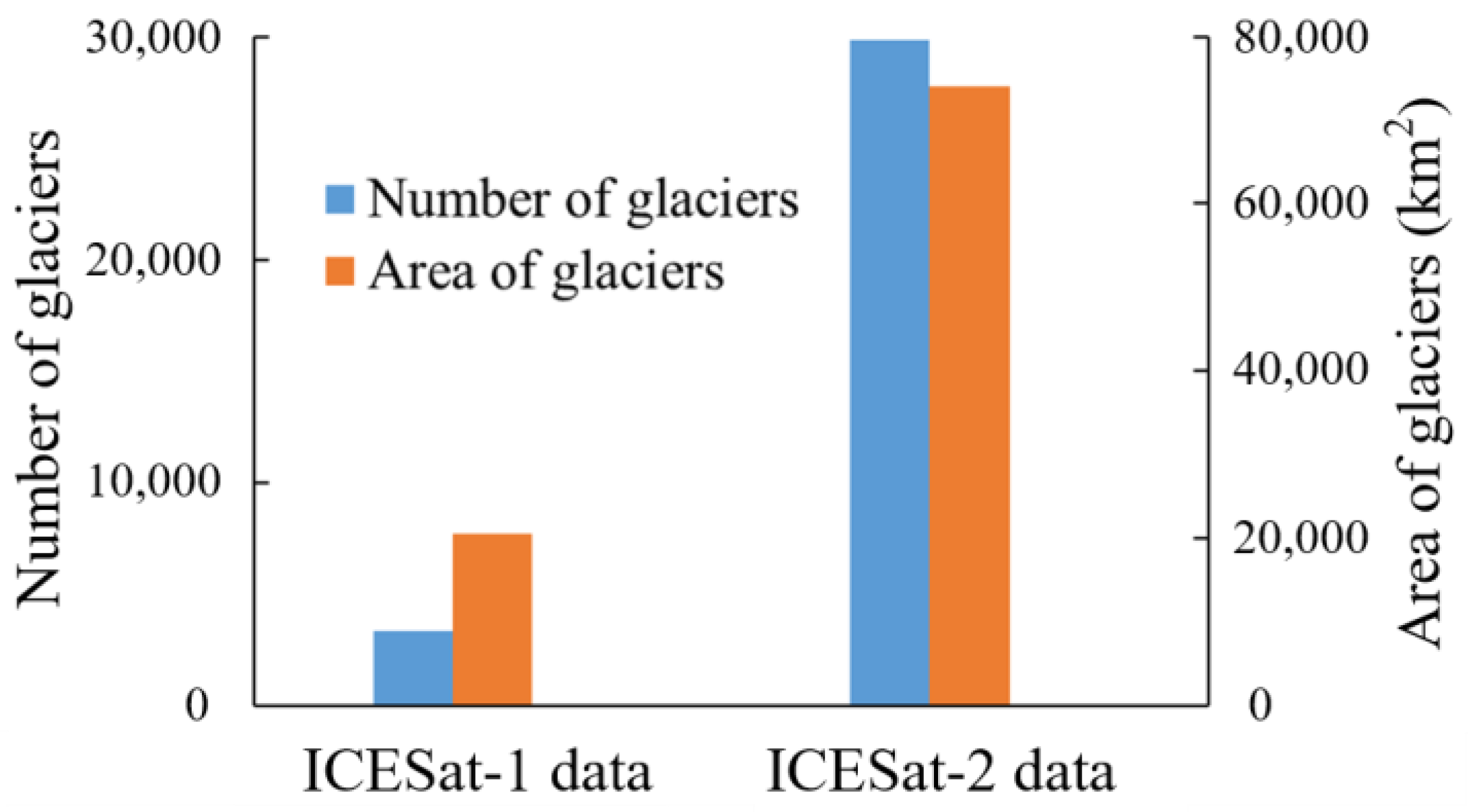
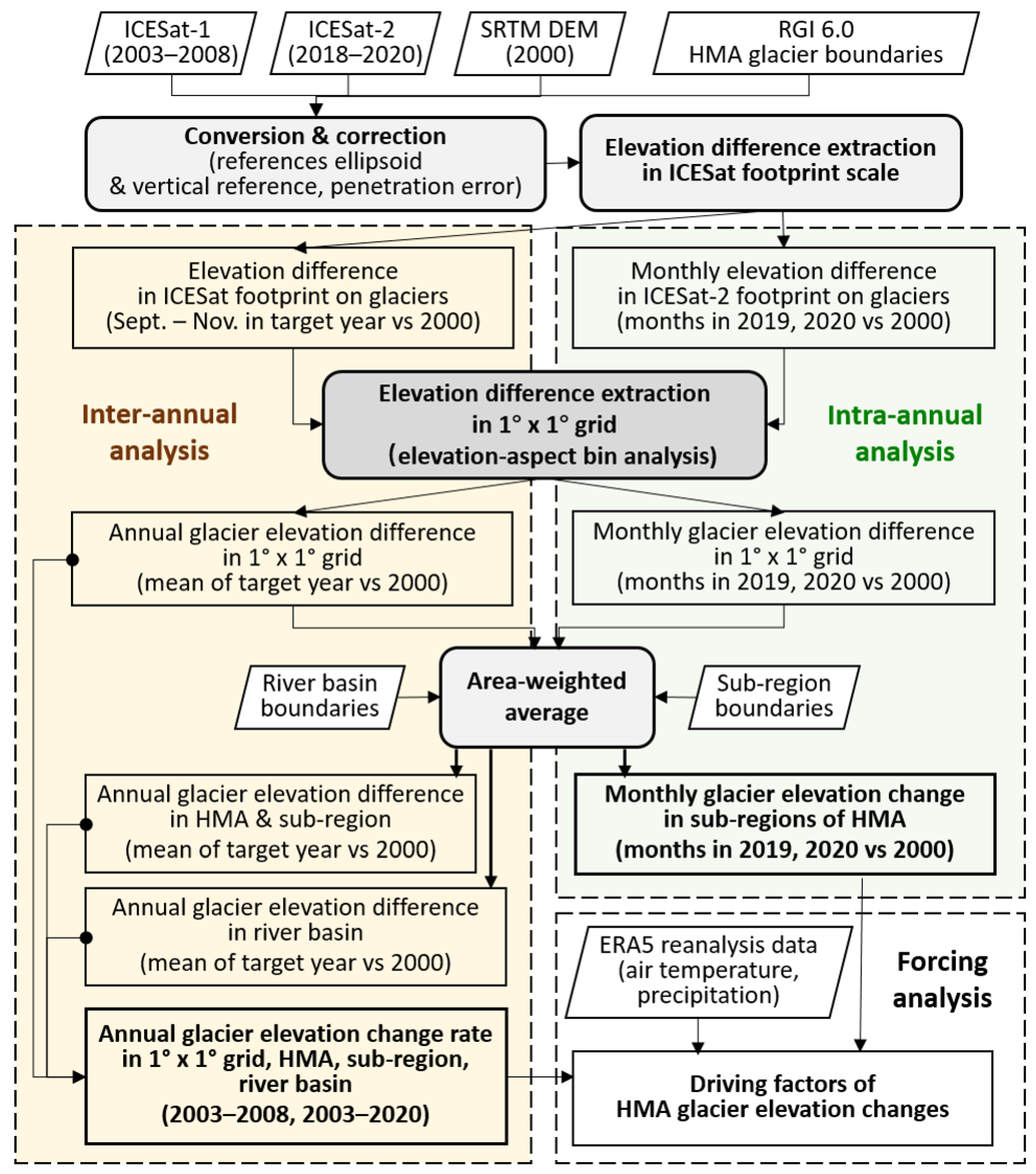
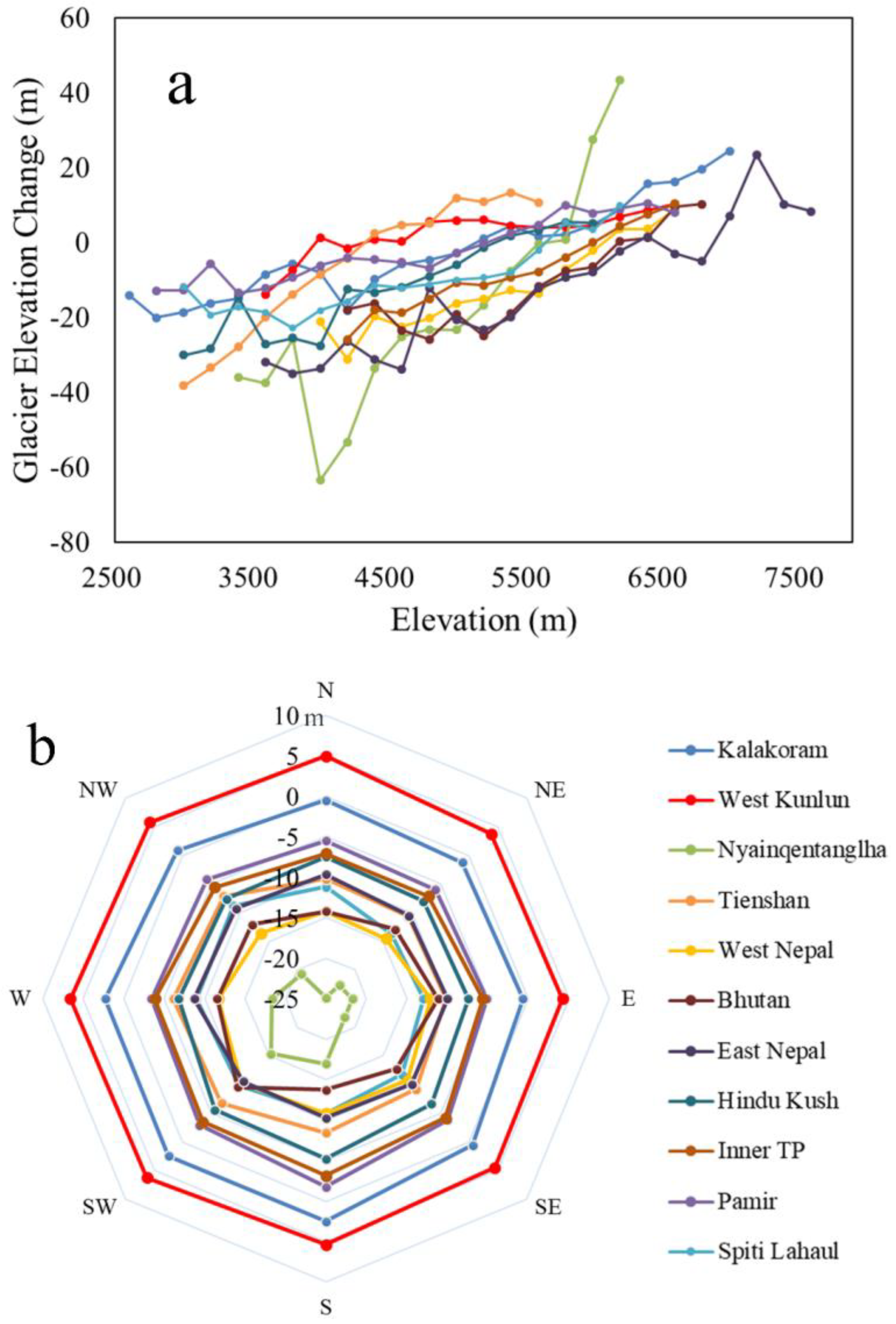

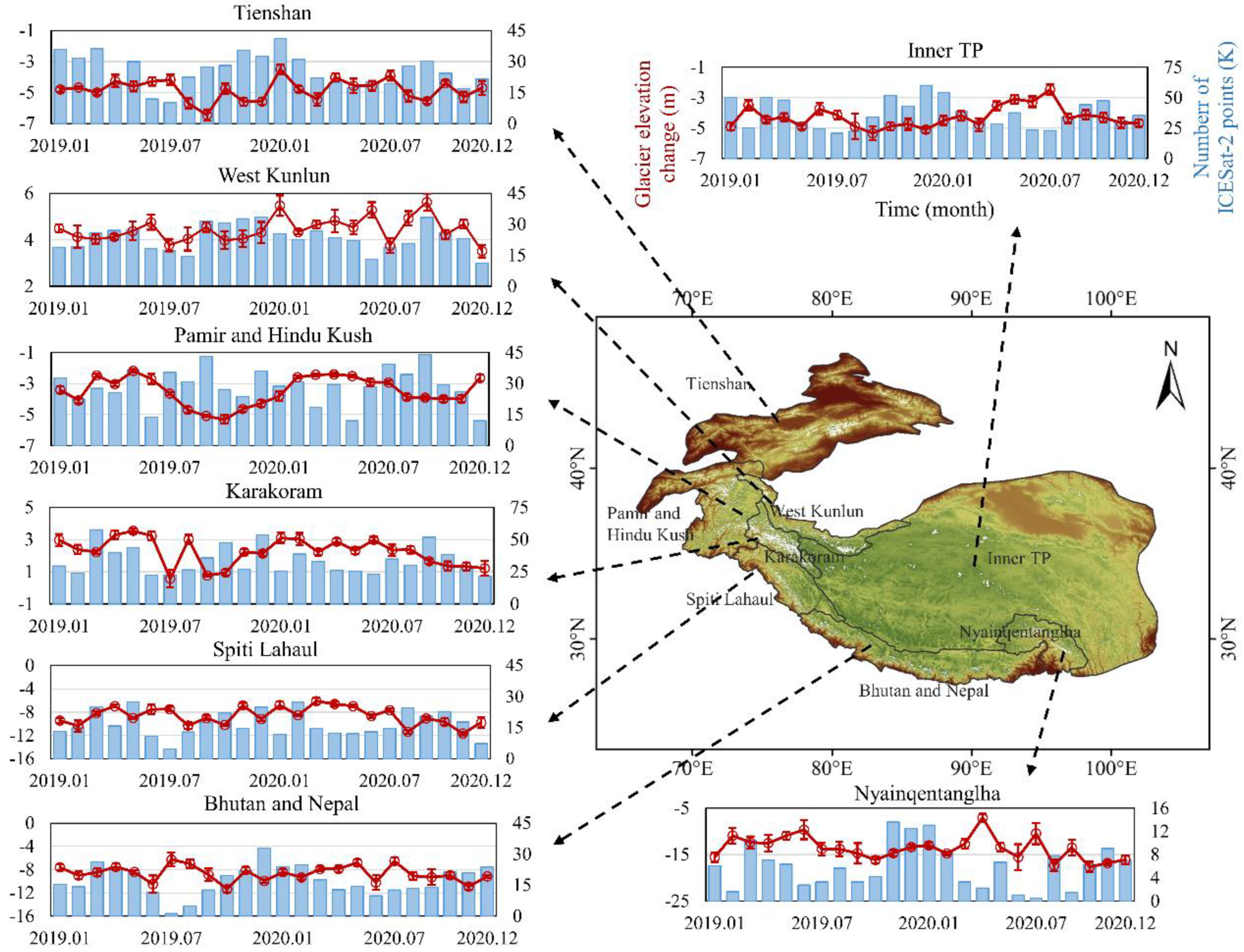

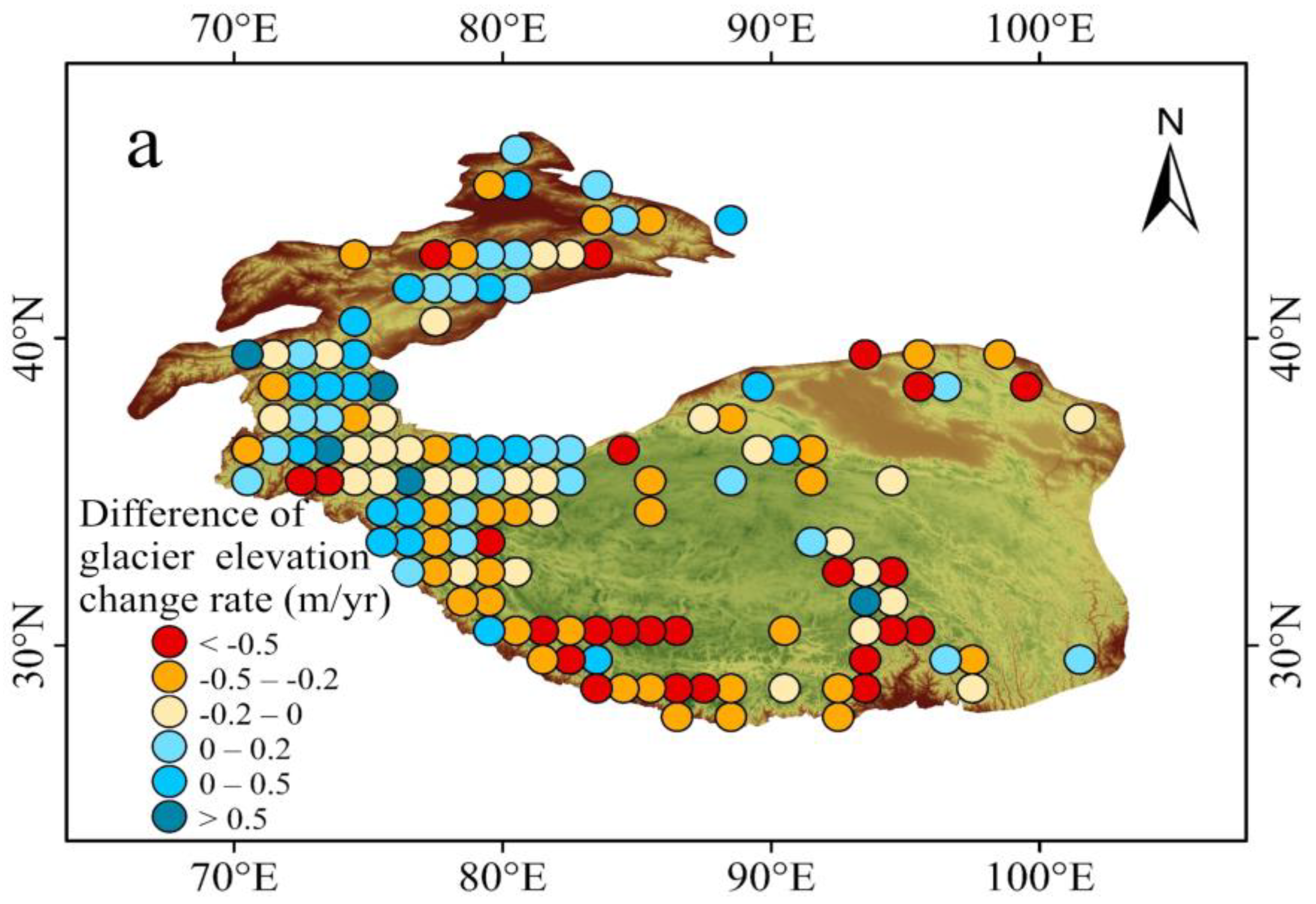

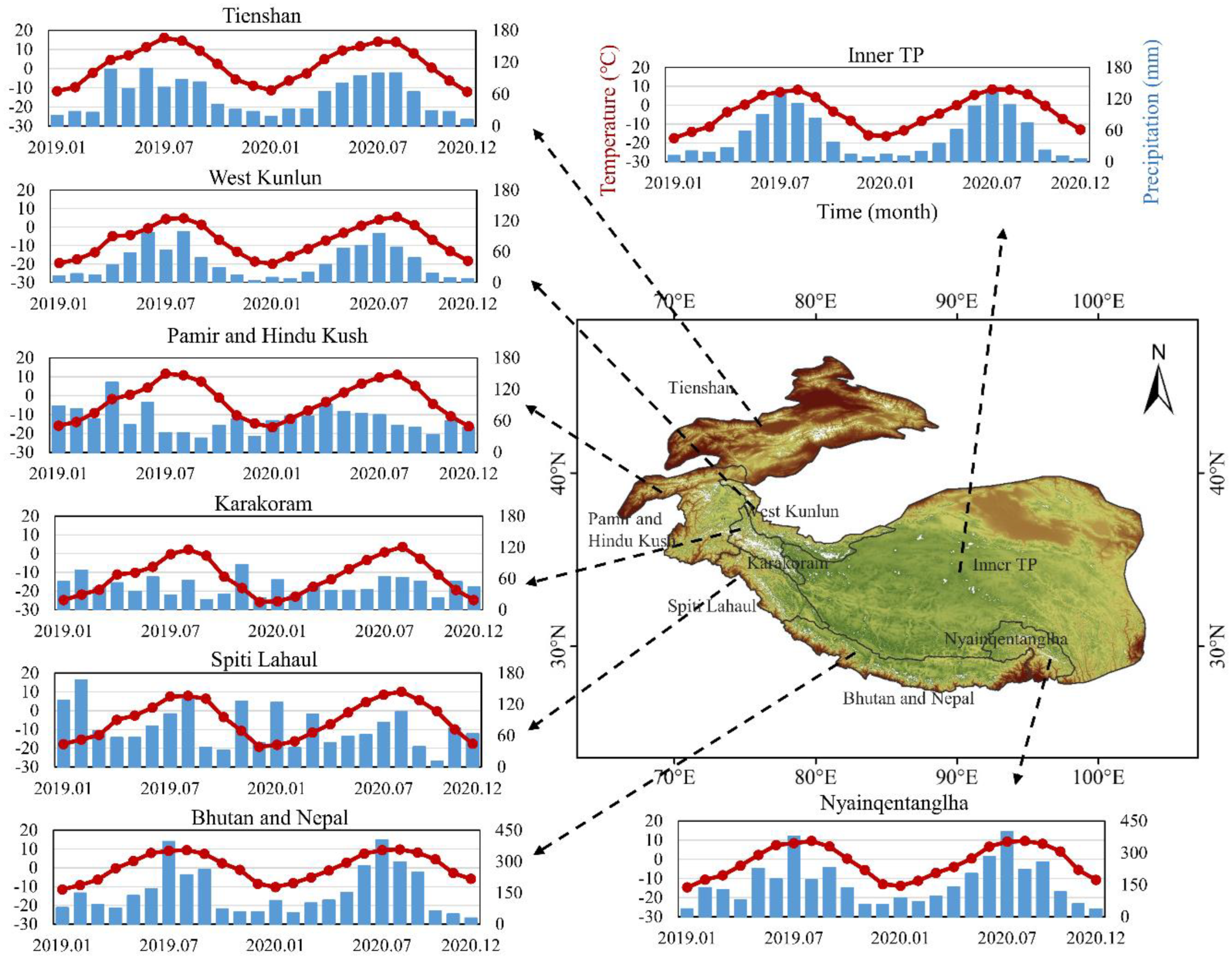
| Basin Name | Glacier Elevation Change Rate (m/year) | |
|---|---|---|
| 2003–2008 | 2003–2020 | |
| Amu Darya | −0.21 ± 0.13 | −0.12 ± 0.11 |
| Brahmaputra | −0.43 ± 0.18 | −0.78 ± 0.13 |
| Ili river | −0.46 ± 0.13 | −0.40 ± 0.12 |
| Indus river | −0.25 ± 0.15 | −0.20 ± 0.12 |
| Qiangtang Plateau | 0.07 ± 0.12 | −0.04 ± 0.11 |
| Shule and Heihe river | −0.11 ± 0.18 | −0.44 ± 0.15 |
| Ebinur and Manas river | −0.10 ± 0.30 | −0.42 ± 0.18 |
| Mekong river | −0.34 ± 0.43 | −1.2 ± 0.33 |
| Qardam | −0.21 ± 0.20 | −0.37 ± 0.13 |
| Issyk-Kul lake | 0.10 ± 0.2 | −0.39 ± 0.14 |
| Salween | −0.69 ± 0.20 | −1.02 ± 0.14 |
| Syr Darya | −0.67 ± 0.16 | −0.34 ± 0.13 |
| Tarim river | 0.08 ± 0.14 | 0.08 ± 0.11 |
| Yangtze | −0.43 ± 0.19 | −0.48 ± 0.13 |
| Sub-Regions | This Study | Wang et al. [31] | Maussion et al. [30] |
|---|---|---|---|
| Spiti Lahaul | December–March | December–March | December–February |
| Bhutan and Nepal | February–July | / | March–August |
| Nyainqentanglha | October–April (June) | December–June | December–August |
| West Kunlun | March–June, July–September | March–June (August) | March–May |
| Pamir and Hindu Kush | October–March | November–April | December–February |
| Tienshan | September–April | December–June | / |
| Karakoram | October–January | / | December–February |
| Inner TP | summer | April–August | June–August |
Publisher’s Note: MDPI stays neutral with regard to jurisdictional claims in published maps and institutional affiliations. |
© 2022 by the authors. Licensee MDPI, Basel, Switzerland. This article is an open access article distributed under the terms and conditions of the Creative Commons Attribution (CC BY) license (https://creativecommons.org/licenses/by/4.0/).
Share and Cite
Shen, C.; Jia, L.; Ren, S. Inter- and Intra-Annual Glacier Elevation Change in High Mountain Asia Region Based on ICESat-1&2 Data Using Elevation-Aspect Bin Analysis Method. Remote Sens. 2022, 14, 1630. https://doi.org/10.3390/rs14071630
Shen C, Jia L, Ren S. Inter- and Intra-Annual Glacier Elevation Change in High Mountain Asia Region Based on ICESat-1&2 Data Using Elevation-Aspect Bin Analysis Method. Remote Sensing. 2022; 14(7):1630. https://doi.org/10.3390/rs14071630
Chicago/Turabian StyleShen, Cong, Li Jia, and Shaoting Ren. 2022. "Inter- and Intra-Annual Glacier Elevation Change in High Mountain Asia Region Based on ICESat-1&2 Data Using Elevation-Aspect Bin Analysis Method" Remote Sensing 14, no. 7: 1630. https://doi.org/10.3390/rs14071630






